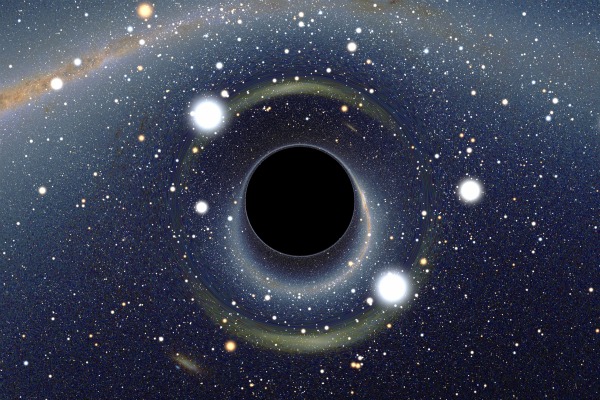Can Anything Escape from a Black Hole?

Black holes are the blackest things in the universe. Because of their enormous, space-bending gravity, everything that falls into them is instantly ripped apart and lost. Scientists have never seen a black hole, because nothing, not even light, can escape them.
Well, almost nothing.
Here on Earth, students of beginner's-level quantum mechanics learn that in the subatomic world, no barrier is insurmountable. Elementary particles (such as photons and electrons) aren't like bouncy balls that, when thrown at a wall, ricochet off it; they're more like ghosts . Barriers encourage these ghostly particles to stay mostly within a given area, but occasionally the particles will pass right through them. This strange behavior is called "quantum tunneling," and not even black holes are immune to it.
Crawling out of holes
According to Andew Hamilton, an astrophysicist at the University of Colorado, the horizon of a black hole is an insurmountable barrier for the likes of us humans and, indeed, anything else larger than an atom. But every once in a while, a subatomic particle manages to pass through it. Thus, it is believed that all black holes emit an incredibly faint glimmer of stuff, named "Hawking radiation" after Stephen Hawking, the physicist who first theorized its existence in the 1970s.
"Classically, there's no way that any radiation is going to escape from a black hole," Hamilton told Life's Little Mysteries. "Inside the horizon, space is falling faster than light, so nothing can emerge from it without traveling faster than light the other way. But quantum mechanically, there's some possibility that something inside can tunnel out."
Doing so requires very special conditions, however.
Get the world’s most fascinating discoveries delivered straight to your inbox.
As well as allowing quantum tunneling, quantum mechanics allows particles to randomly pop into existence. In fact, such "quantum fluctuations" happen all the time: Particle-antiparticle pairs spontaneously arise from the vacuum of space (and usually immediately annihilate each other).
For a particle to escape a black hole, a quantum fluctuation must occur near a black hole's edge. When this happens, sometimes one particle will tunnel out before the annihilation can take place. Its partner immediately gets "spaghettified" by the black hole elongated as it plunges to the center.
In order for this dramatic separation to happen, the particles produced in the quantum fluctuation must have very long wavelengths. Strange as it may sound, quantum mechanics says that all particles, as we usually refer to them, are also waves, and thus they have wavelengths that describe the distance between their successive peaks. The slower a given particle/wave is moving, the longer its wavelength.
Particles that are produced by quantum fluctuations and that have "wavelengths that are comparable to the size of the black hole are able to tunnel out," Hamilton said. "This is because they cannot be localized they're fuzzy." To use the earlier analogy, these particles are especially ghostlike. Their huge wavelengths make them free to roam in domains that extend beyond the boundary of the black hole.
"Hawking radiation has a characteristic wavelength which is comparable to the size of the horizon of the black hole," Hamilton said. In the case of the black hole that is at the center of our Milky Way galaxy , particles tunneling out from it have wavelengths approximately 14 times the radius of our sun. For supermassive black holes, particles must have wavelengths billions of suns long in order to tunnel out. [Infinity Symbol Found at Center of Milky Way ]
Darn dim
As you may have guessed, there aren't a whole lot of particles that fit the criteria required to escape black holes.
Even the brightest holes (which are the smallest ones, because these have less gravity and therefore allow more particles to escape) are "pretty darn dim," Hamilton said. The Hawking radiation from a small, 30-sun-size black hole is just one billion-trillion-trillionth as bright as a 100-watt light bulb.
This radiation is completely swamped by light from other bright objects in space, and so scientists have not yet managed to detect Hawking radiation. Nonetheless, they're sure it exists. "Hawking radiation is considered one of the most robust predictions of quantum gravity," Hamilton said.
- 6 Everyday Things that Happen Strangely In Space
- The Mysterious Physics of 7 Everyday Things
- Top 3 Questions People Ask an Astrophysicist (and Answers)
Follow Natalie Wolchover on Twitter @nattyover. Follow Life's Little Mysteries on Twitter @llmysteries, then join us on Facebook.
Natalie Wolchover was a staff writer for Live Science from 2010 to 2012 and is currently a senior physics writer and editor for Quanta Magazine. She holds a bachelor's degree in physics from Tufts University and has studied physics at the University of California, Berkeley. Along with the staff of Quanta, Wolchover won the 2022 Pulitzer Prize for explanatory writing for her work on the building of the James Webb Space Telescope. Her work has also appeared in the The Best American Science and Nature Writing and The Best Writing on Mathematics, Nature, The New Yorker and Popular Science. She was the 2016 winner of the Evert Clark/Seth Payne Award, an annual prize for young science journalists, as well as the winner of the 2017 Science Communication Award for the American Institute of Physics.




